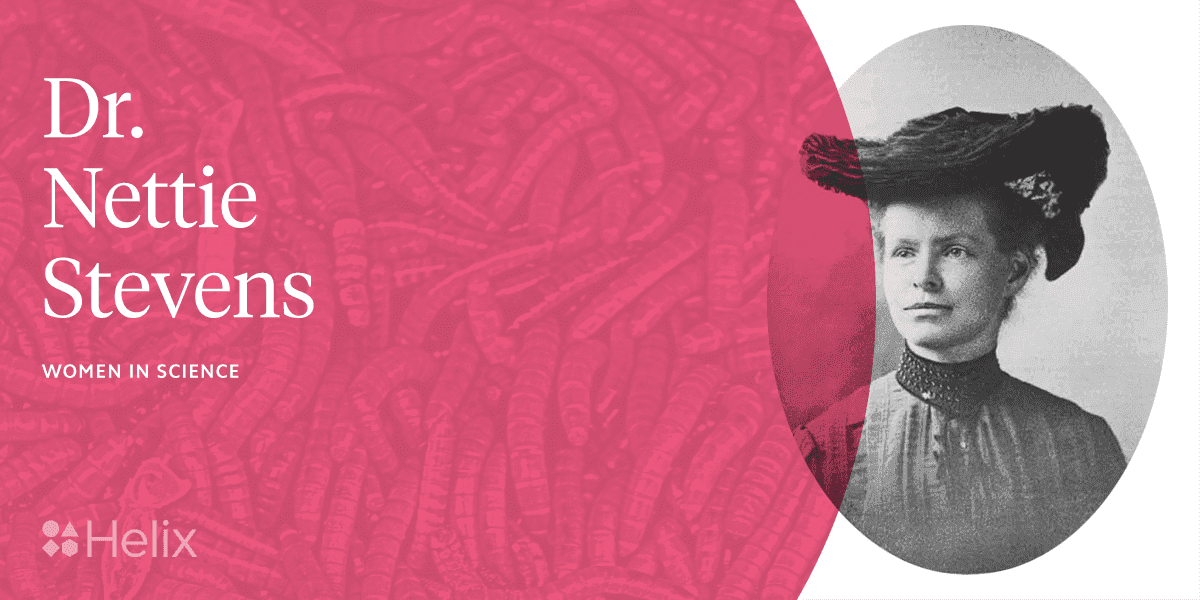Dr. Nettie Stevens: Making genetics history with mealworms

For much of human history, people thought that a baby’s biological sex was the result of environmental factors rather than their DNA. This theory prevailed until 1905, when a promising young researcher showed that biological sex is determined by our chromosomes. That researcher was Dr. Nettie Stevens.
Dr. Stevens has been described as a curious, independent, and admirable researcher who had a passion for zoology. This passion would motivate her to leave her teaching job in search of a career in science and, between 1896 and 1900, she managed to get both a bachelor’s and a master’s degree from Stanford University. Over the next few years, she would go on to publish nine papers and was awarded her PhD in 1903.
Dr. Stevens was coming into science at a time when there was very little known about heredity. For instance, Charles Darwin published his seminal work On the Origin of Species just two years before Dr. Stevens was born. With regards to DNA, we knew even less. Scientists were only just starting to understand that chromosomes were separate entities (as opposed to one blob of material), and whether these chromosomes held unique information from one another was a topic of debate. Dr. Stevens brought some clarity to this debate by demonstrating that there were unique chromosomes that could dictate an organism’s biological sex.
Chromosomes are passed between generations through specialized cells known as germ cells; you may know them as sperm cells and egg cells. What makes these cells special is that they only carry one copy of each chromosome. This means that when a sperm fertilizes an egg, there will be a “normal” number of chromosomes. It was known that sperm were needed for fertilization (thanks to—believe it or not—frogs with pants), but scientists didn’t know what role the chromosomes within the sperm played in sex determination. In fact, they believed it was a mother’s diet and environment that determined the baby’s sex, not DNA. This notion was weakened by some studies in the 1800s suggesting a role for chromosomes, and fell apart completely in 1905 when Dr. Stevens published a paper describing the presence of sex determining chromosomes.
Dr. Stevens started researching this topic using some unlikely test subjects: aphids and beetles. These creatures proved to be ideal models for many reasons, but the common mealworm beetle (Tenebrio molitor) was particularly useful. Like humans, this beetle inherits half of its chromosomes from its parent’s sperm, and the other half from the egg. By examining the sperm of the mealworm, Dr. Stevens observed that some sperm carried 19 large chromosomes, and one small chromosome. In contrast, other sperm carried 20 large chromosomes, and no small ones. More importantly, she observed that the sperm with a small chromosome always gave rise to biologically male offspring. In other words, there appeared to be a pair of chromosomes—one large and one small—that could determine if the worm was male or female. She called the large chromosomes the “X” chromosomes, and the small one the “Y” chromosome.
By consistently observing this phenomena, Dr. Stevens provided the first strong evidence showing that an organism’s sex was determined at the moment of fertilization based on its chromosomes, rather than its environment during development. Simultaneous to her discovery, Dr. E. B. Wilson published similar results. Both he and Dr. Stevens contributed significantly to our understanding of sex chromosomes. Though Dr. Stevens made her discovery independent of Dr. Wilson—and her findings were considered to be more substantially conclusive than his—Dr. Stevens has often been overshadowed by Dr. Wilson due to his well-known work in animal evolution and cell biology. Unfortunately, this has resulted in very little acknowledgment over the years of Dr. Stevens’ influential role in science history.
It goes without saying that Dr. Stevens and her work should be celebrated. From an early age, she strived to become a scientist and worked throughout her life to make that happen. Dr. Nettie Stevens died just 9 years after receiving her PhD, but in that time she was able to publish 40 research articles—a furious pace by any standard—and set the stage for our modern understanding of biological sex determination.
